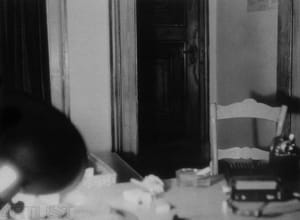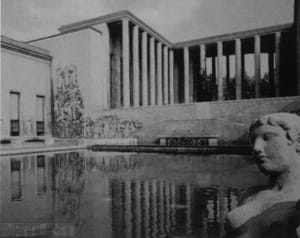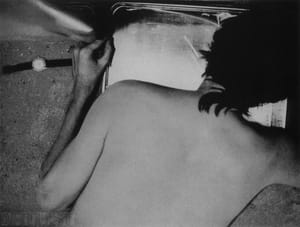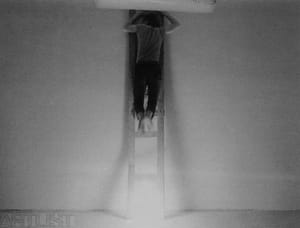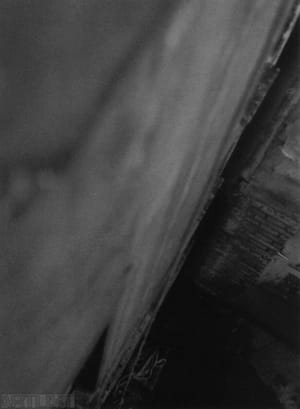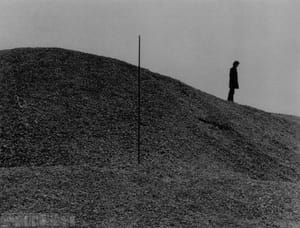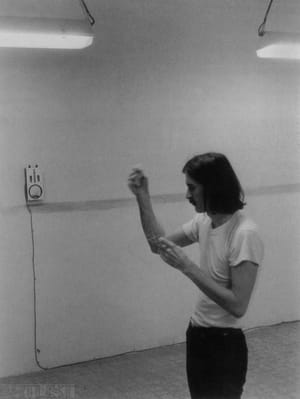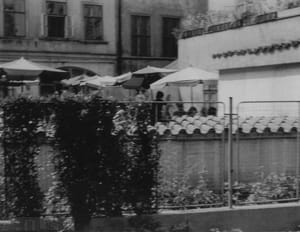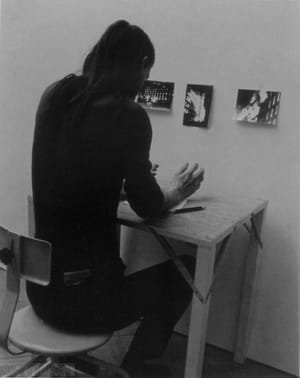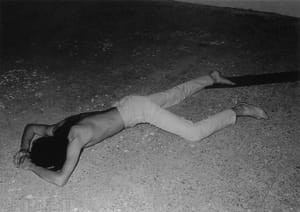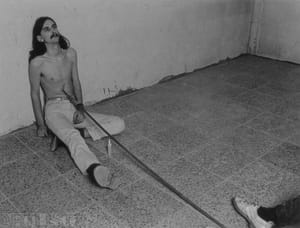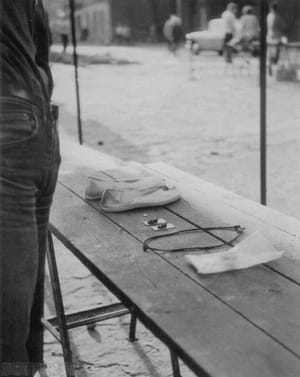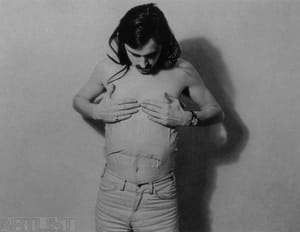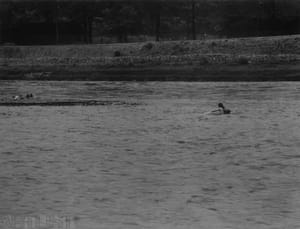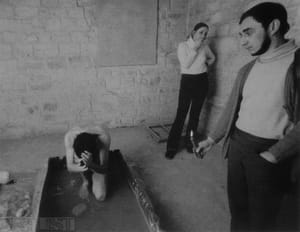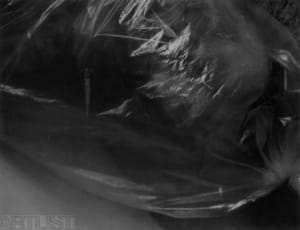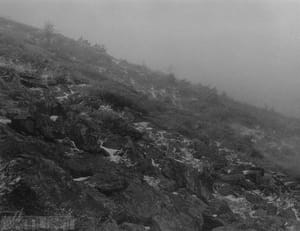- First Name
- Jan
- Surname
- Mlčoch
- Born
- 1953
- Birth place
- Praha
- Place of work
- Praze
- CSU Library
- ↳ Find in the catalogue
About artist
Jan Mlčoch’s action art was highly influenced by his meeting with Karel Miler and Petr Štembera, which gave him the impetus to move away from recording his dreams and activities in a journal and towards the creation and documentation of short texts and photography. As in the case of other members of the Prague body art scene, performance was very important not only for artistic reasons. In the difficult social situation after the occupation of 1968, when “socialism with a human face” was replaced by the second phase of implacable totalitarianism in what is known as the period of normalisation, performance was one of the possibilities of free personal testimony, a way of balancing a fragile relationships with the world.
Mlčoch held his first event in 1974, when in atrocious weather he repeated Ascent on Mount Kotel. His favourite themes are already in evidence, such as isolation, departure, and the return to people. In his second event, Plastic Bag (1974), this element returned. He sealed himself in a plastic bag and remained in it for 34 minutes, until such time as he had lost control over himself and sliced open the bag. This event was strikingly similar to the work of Petr Štembera, in which the performer’s body is often exposed to a dangerous situation that escalates to the very borders of what is possible. This moment appeared in several other of Mlčoch’s events, such as Fire Doors (1975), 20 minutes (1975), Paris 1977 (1977) and Ladder (1977). However, his work differs from Štembera’s by virtue of an economy of expression and intrinsically inner experience that, though everything takes place before the viewer’s eyes, can only be instinctively perceived. Another difference in the work of these two friends is the role that Mlčoch accords his viewers, whom he involves in his events. For instance, in 20 Minutes (1975) he asked one of the viewers to collaborate and to increase the pressure of the knife on the artist’s stomach whenever the latter seemed in danger of drifting off.
One of his key events was Suspension – Great Sleep (1974), in which he had himself suspended by hand and feet with a blindfold on and covered ears in a huge loft. His body entered a kind of weightless state that for several minutes allowed him to experience pure being free of the burden of everyday life. As was often said at that time in the sphere of Czechoslovak action art, every event has four parts: the idea, the vision, the realisation and the documentation. In Mlčoch’s the vision plays the most important role. His events are often enigmatic situations that we might expect to find in dreams rather than everyday reality. It is no coincidence that the philosopher Petr Rezek was inspired by the event above to interpret the performance as though it were a dream. He touched upon many of the fundamental features of action art, since the action, even though it frames real life and raises it to another level, nevertheless remains as strongly anchored in it as a dream.
During the 1970s, Mlčoch realised more than twenty actions in which he used a wide variety of expressive possibilities. As well as his purely body art performances, he also realised many actions concerned with social questions, the opposition between the personal and the social, the interior and exterior, etc. He was one of the first Czechoslovak body artists to address political themes. This was in an event that took place in 1977, Bianco a Noc. However, most of Mlčoch’s works are more personal in character. Some took place in isolation, and some in front of a small audience, whether of the artist’s close friends or casual passersby.
From today’s perspective the most interesting events that Mlčoch ever realised were those that took place in public space. In 1975, for example, in Remembering P (1975), he sold those personal effects that reminded him of his friends at a market, or in 1980, when he organised a homeless shelter at the Gallery De Appel in Amsterdam, which basically prefigured contemporary participatory art. These were his last works. Like Petr Štembera and Karel Miler, at the end of the 1970s he decided to give up his action art events.
- Author of the annotation
- Pavlína Morganová
- Published
- 2003
CV
Studies:
1968-1971 Secondary Industrial School, Náchod
Awards:
2005 Osobnost české fotografie za rok 2005
Exhibitions
- Group exhibitions not included in ARTLIST.
-
2012
Museo de las narrativas paralelas. En el marco de La Internacional / Museu de les narratives paral·leles. En el marc de La Internacional / Museum of Parallel Narratives. In the framework of L'Internationale, Museu d'Art Contemporani de Barcelona (MACBA), Barcelona
Civilizované iluze: Fotografická sbírka Muzea umění Olomouc, Muzeum umění Olomouc - Muzeum moderního umění, Olomouc
2011-2012
V plném spektru. Fotografie 1900-1950 ze sbírky Moravské galerie v Brně, Pražákův palác, Brno
Luciferův efekt / The Lucifer Effect, DOX, Velká hala + mezonet 1. patra, Praha
2009
Tschechische Fotografie des 20. Jahrhunderts, Kunst- und Ausstellungshalle der Bundesrepublik Deutschland, Bonn
2007
Tschechische Aktionskunst der 1960er bis 1990er Jahre / České akční umění 60. - 90. let, Tschechisches Zentrum Berlin (České centrum Berlín), Berlín (Berlin)
Prague Biennale 3 - Global and Outsiders: Connecting Cultures in Central Europe, Karlínská hala, Praha
2006
Od země přes kopec do nebe...: O chůzi, poutnictví a posvátné krajině, Zámek Klenová, Klenová
2005
Od země přes kopec do nebe...: O chůzi, poutnictví a posvátné krajině, Severočeská galerie výtvarného umění v Litoměřicích, Litoměřice
2002
Corps et traces dans la création tchèque 1962-2002, Musée des Beaux-Arts, Dijon
2001-2002
Jiří Kolář sběratel / Jiří Kolář the Collector, Veletržní palác, Praha
1997
Umění zastaveného času / Art when time stood still, Česká výtvarná scéna 1969-1985, Brno (Brno-město), Brno
1995
Písmo ve výtvarném umění, Malá galerie Na hradbách, Kolín
1991
Umění akce, Mánes, Praha
1979
Miejsca i chwile, Foto Medium Art (Ośrodka Kultury i Sztuki we Wrocławiu), Vratislav (Wrocław)
1977
Body as a Visual Language, Gallery Maki, Tokio (Tokyo)
1976
Příroda Nature, Galerie Institutu průmyslového designu, Praha
- Collections
-
Galerie Marie Potocké, Krakow
Moravská galerie v Brně, Brno
Národní galerie v Praze, Praha
Monography
- Monography
Katalog vydaný u příležitosti výstavy v Galerii hl. města Prahy, (Miler Karel, Štembera Petr, Mlčoch Jan), 1997
- Personal texts not included in database
Česká fotografie 20. století, Birgus Vladimír, Koenigsmarková Helena , Malá Olga , Mlčoch Jan , Srp Karel mladší, KANT, Praha 2005
Fotografie v českých zemích 1839-1999, Birgus Vladimír - Mlčoch Jan, Praha 1999



